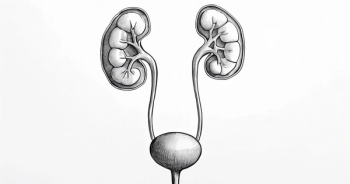
Peers & Perspectives in Oncology
- April 2025
- Pages: 90
Managing Colorectal Cancer Requires Using All Available Options
Key Takeaways
- Refractory metastatic CRC patients have multiple therapy options, including trifluridine/tipiracil with bevacizumab, fruquintinib, and regorafenib.
- The SUNLIGHT trial showed significant survival benefits with trifluridine/tipiracil and bevacizumab, supporting its early use in refractory settings.
In an interview with Peers & Perspectives in Oncology, John L. Marshall, MD, discussed treatment approaches and sequencing for refractory colorectal cancer.
Patients whose disease is refractory to initial therapy for metastatic colorectal cancer (CRC) can still benefit from additional therapies, and multiple options are available regardless of molecular subtype. Data on sequencing the 3 FDA-approved regimens for refractory disease are limited, and patients can receive multiple lines and have good outcomes. Still, in some cases, they do not receive each approved therapy in sequence.
“What shocks me on some level is the number of patients who don’t end up having all 3 choices,” said John L. Marshall, MD, in an interview with Peers & Perspectives in Oncology.
Marshall, director of the Ruesch Center for the Cure of Gastrointestinal Cancers at Georgetown Lombardi Comprehensive Cancer Center in Washington, DC, discussed the use of these therapies, focusing on the SUNLIGHT trial (NCT04737187) data that supported the combination of trifluridine/tipiracil (TAS-102; Lonsurf) with bevacizumab (Avastin), which some patients had already received in prior lines. The efficacy outcomes with the addition of bevacizumab, including a 56% improvement in progression-free survival and 39% improvement in overall survival,1 justified this regimen being used early [on] in the refractory setting. However, treatment selection depends on each patient’s condition and what they have already received, according to Marshall.
Marshall also raised the issue of nonmedical factors that influence the availability of these regimens and the importance of staying aware of new targeted therapies that can offer additional efficacious approaches in this patient population.
Peers & Perspectives in Oncology: Could you describe the current landscape of treatment options in refractory metastatic CRC?
Marshall: Colon cancer is a very common disease. [Over] 50,000 people a year in the United States are going to have metastatic disease, and too many of those will die of their cancer. The ones who do die of their cancer are [part of] this refractory metastatic patient population. When we think about what that means, those are people who’ve already had oxaliplatin-based therapy, irinotecan-based therapy, and typically also any biologic [such as an] EGFR or VEGF inhibitor if they’re a candidate. We now have microsatellite unstable and BRAF-targeted therapies, and those drugs are being used earlier [on]. That leaves patients who…usually feel well [but] don’t have resectable cancer; they’re incurable. We now have 3 choices in the refractory metastatic setting: [trifluridine/tipiracil] plus bevacizumab; fruquintinib [Fruzaqla], a newer agent; and regorafenib [Stivarga] as the treatment choices in that patient population.
For the most part, patients in the refractory metastatic setting are doing OK. They’ve already been undergoing treatment for 1 to 2 years. With cancer, we always worry about pain, organ dysfunction…and fatigue. We would like to have cancer shrink, but stable disease can be meaningful for these patients…so their needs are maintaining quality of life, maintaining function, and preventing progression of cancer.
Describe the outcomes of the SUNLIGHT trial of trifluridine/tipiracil and bevacizumab .
We had [trifluridine/tipiracil] already demonstrating benefit in patients in the refractory metastatic setting compared with placebo.2 But the question was, based on some evidence and clinical ideas, that if we…added the VEGF inhibitor bevacizumab beyond progression, would we continue to see benefit? This was a clinical trial asking that question. Half the patients got [trifluridine/tipiracil] by itself. The other half of the patients got [trifluridine/tipiracil] plus beva-cizumab, and the positive results were quite significant. There was not only an improvement in progression-free survival and overall survival, there were also a few patients who had some response.1
One criticism of this is that some of these patients hadn’t [received] a lot of prior bevacizumab, like we do here in the United States, but there were a lot of people who did [receive] prior bevacizumab. What I think this did was prove in this patient population that VEGF inhibition beyond progression is a valuable therapy and has become the standard of care.
How has this regimen affected metastatic CRC treatment since its approval?
At the same time this was happening, we also had the new drug fruquintinib coming along, and we already had regorafenib. So there is some jockeying...for what you would try first, second, or third. What shocks me on some level is the number of patients who don’t end up having all 3 choices, because they’re different and they work in different ways. My bias tends to be using the [trifluridine/tipiracil]/bevacizumab in those patients early on and then saving fruquintinib and regorafenib for later. In my opinion,…the positive data from SUNLIGHT give you good enough validation that this is a reasonable choice in that window earlier on, but I would not fault a physician for using regorafenib or fruquintinib earlier as well. The main point is don’t leave these drugs on the table.
What factors affect the sequencing of these 3 drugs?
You are always looking at…the next best chess move to play, and a lot depends on what you have played before. How much VEGF inhibition have you been giving? Has there been a break [in treatment] or not? Does the patient want to break from an intravenous treatment and only do oral therapies? What have the [adverse events] before been?
You want to not just have a routine…checkers-like approach to managing metastatic colon cancer. You want a chess-like approach, and you’re a better chess player if you look at what’s happened before and what you’ve got left ahead of you.
What unanswered questions would you like to see more research into in this disease setting?
The biggest issue we have for our patients is novel therapies and novel targets. The nice thing about these drugs is that there isn’t a specific molecular subtype for them, but we have to remember that now, with BRAF, HER2, and microsatellite [instability-high disease], those patients have additional choices. We are hopefully soon going to have some RAS mutation–targeted therapies in colon cancer. This will have a big impact as well, but this still leaves a lot of patients who don’t have those choices. Even patients with those choices will need alternative approaches. All of us need to be up to speed on these agents and how best to give them.
…As an experienced colorectal cancer physician, I don’t really like the approved doses and schedule of these drugs. For example, with [trifluridine/tipiracil], it’s [given for] 2 weeks in a row and then 2 weeks off. I find that difficult to use, and so I automatically go to every other week. I sometimes do modifications with fruquintinib, and we are all modifying regorafenib based on [data from] clinical trials. I think optimizing dose and schedule is important…to get the best outcomes and improve patient quality of life.
What other issues are challenging in this disease setting?
One component that is affecting us, but we don’t talk about very much, is that there are pharmacy benefit managers who have a script by their side. I might want to use one of these 3 drugs, but they write back and say, “No, not until you’ve used the other [ones first].” There has been some external influence, not medical but insurance based, on the sequence of our therapies. If any of us out there encounter that, we need to share that information and make sure…there is an awareness that that’s not their call; that’s our call.










































